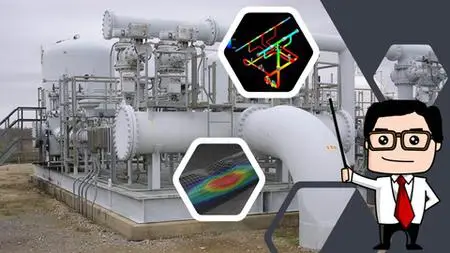Learn Caesar Ii : The Complete Piping Stress Analysis Course
Last updated 7/2022
MP4 | Video: h264, 1280x720 | Audio: AAC, 44.1 KHz
Language: English | Size: 2.76 GB | Duration: 4h 56m
Last updated 7/2022
MP4 | Video: h264, 1280x720 | Audio: AAC, 44.1 KHz
Language: English | Size: 2.76 GB | Duration: 4h 56m
Learn everything you need to know about piping stress analysis using CAESAR II software, from beginner to expert - 2022
What you'll learn
Basics of pipe stress analysis
Types of loads, stresses and loads combinations on piping systems as per ASME code
ASME Code requirements for pipe stress analysis
Types of piping supports [Rigid supports, Variable supports, Hangers…etc]
How to use CAESAR II software to create any piping 3D Model
How to add and define different piping fittings such as bends, Tees, Flanges, Valves, Expansion bellows…etc
How to model pumps & vessels nozzles in CAESAR II software
How to interpret the stress analysis output and to optimize supports design
How to compare system stresses and deformations with the code allowable limits
Requirements
No experience needed, you will learn everything you need to know
Description
This course is perfect for any engineer interested to start a career in piping stress analysis but overwhelmed by many unorganized information and doesn't know from where to start.This course is designed to guide you through piping stress analysis process - using CAESAR II - starting from scratch till being able to understand piping isometric drawings, creating a full 3D analysis model, choosing supports types & locations, checking code requirements and finalizing the design drawings/report.This course consists of 4 sections which are as following :-Section One :-In this section, you will learn the very basics of the piping stress analysis including when & why do we have to carry out piping stress analysis, and the main concepts such as- Loads & stresses on the system- Loads combinations- ASME Code compliance- Supports optimization.- Pipe stress analysis workflowOnce you are familiar with the piping stress analysis workflow, you will be ready for the following sectionSection Two :-In this section you will learn how to create a new model from scratch on CAESAR II and how to model many components such as pipe bends, tees, valves, expansion bellows, pumps and basically any kind of fitting might be in your system.Also, during modeling you will learn multiple advanced techniques such as- How to model pumps nozzle- How to model surge vessels- How to model steel structuresAnd many other modelling modifications techniques such as stretching, mirroring, adding segments…etc.Once the 3D modeling is finalized, you will be ready for the following sectionSection Three :-In the third section, you will start investigating the output results of the analysis of CAESAR II including the system deformations, stresses, pump nozzle loads, supports optimization, and we will learn how to understand and asses the system's behavior and how to fix any failing segments of the system.you will also learn some valuable techniques for pipe rerouting such as expansion loops.Section Four :-In this section, you are going to learn about underground pipe stress analysis including the following- What is the difference between piping and pipeline ?- Why do we have to do pipe stress analysis for underground pipeline ?- When do we have to do it ?- How different is pipe stress analysis for underground pipeline vs above ground]- Supporting systems for underground pipelinesAnd many other important information about underground pipeline systemsExtra Resources :- By the end of the course, and as extra resource, you will receive multiple CAESAR II models files which we have used during our course, this will give you a chance to train and enhance your modeling skills.
Overview
Section 1: Pipe stress analysis basics
Lecture 1 Course introduction
Lecture 2 What is pipe stress analysis ?
Lecture 3 Types of loads & stresses
Lecture 4 Loads combinations & code compliance
Lecture 5 Types of supports
Lecture 6 Pipe stress analysis workflow
Lecture 7 About CAESAR II software
Section 2: CAESAR II 3D Modeling
Lecture 8 Creating new model configuration
Lecture 9 Modeling pipe geometry
Lecture 10 Modeling pipe fittings including bends, tees & reducers
Lecture 11 Modeling valves & flanges
Lecture 12 Modeling pump nozzles
Lecture 13 Copy & paste & Stretching elements
Lecture 14 Adding rigid supports
Lecture 15 Adding trunnion supports
Lecture 16 Modeling & design of hangers
Lecture 17 Modeling steel structures
Lecture 18 Integration between piping and structural models
Lecture 19 Modeling surge vessel nozzle
Lecture 20 Adding wind/siesmic loads
Lecture 21 Running error checker
Lecture 22 Manual model checking
Lecture 23 Setting up load cases
Section 3: Pipe stress analysis output
Lecture 24 Output processor
Lecture 25 Checking system deformations
Lecture 26 Code compliance check
Lecture 27 Optimizing supports
Lecture 28 Optimizing supports [ Expansion loop ]
Lecture 29 Checking forces on supports
Lecture 30 Checking forces on pumps nozzles
Lecture 31 Checking forces on surge vessels nozzles
Section 4: Underground pipeline modeling
Lecture 32 Underground pipeline systems
Lecture 33 Modeling of underground pipelines on CAESAR II
Lecture 34 Underground pipeline example on CAESAR II
Section 5: Conclusion & Additional tips
Lecture 35 Conclusion
Lecture 36 Flange failure check using ASME code method
Engineers who want to learn pipe stress analysis basics for beginners and intermediate level,Engineers who want to learn 3D piping modeling on CAESAR II software,Beginner pipe stress analysts who want to enhance their knowledge and modeling skills,Engineers into process piping field,Engineers into infrastructure water field,Engineers into Petroleum or Oil & Gas field



